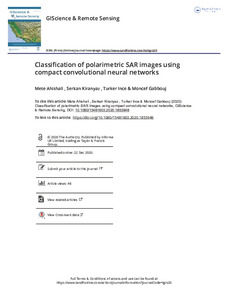Classification of polarimetric SAR images using compact convolutional neural networks
Ahishali, Mete; Kiranyaz, Serkan; Ince, Turker; Gabbouj, Moncef (2021)
Avaa tiedosto
Lataukset:
Ahishali, Mete
Kiranyaz, Serkan
Ince, Turker
Gabbouj, Moncef
2021
Julkaisun pysyvä osoite on
https://urn.fi/URN:NBN:fi:tuni-202012309203
https://urn.fi/URN:NBN:fi:tuni-202012309203
Kuvaus
Peer reviewed
Tiivistelmä
Classification of polarimetric synthetic aperture radar (PolSAR) images is an active research area with a major role in environmental applications. The traditional Machine Learning (ML) methods proposed in this domain generally focus on utilizing highly discriminative features to improve the classification performance, but this task is complicated by the well-known “curse of dimensionality” phenomena. Other approaches based on deep Convolutional Neural Networks (CNNs) have certain limitations and drawbacks, such as high computational complexity, an unfeasibly large training set with ground-truth labels, and special hardware requirements. In this work, to address the limitations of traditional ML and deep CNN-based methods, a novel and systematic classification framework is proposed for the classification of PolSAR images, based on a compact and adaptive implementation of CNNs using a sliding-window classification approach. The proposed approach has three advantages. First, there is no requirement for an extensive feature extraction process. Second, it is computationally efficient due to utilized compact configurations. In particular, the proposed compact and adaptive CNN model is designed to achieve the maximum classification accuracy with minimum training and computational complexity. This is of considerable importance considering the high costs involved in labeling in PolSAR classification. Finally, the proposed approach can perform classification using smaller window sizes than deep CNNs. Experimental evaluations have been performed over the most commonly used four benchmark PolSAR images: AIRSAR L-Band and RADARSAT-2 C-Band data of San Francisco Bay and Flevoland areas. Accordingly, the best obtained overall accuracies range between 92.33–99.39% for these benchmark study sites.
Kokoelmat
- TUNICRIS-julkaisut [16983]
